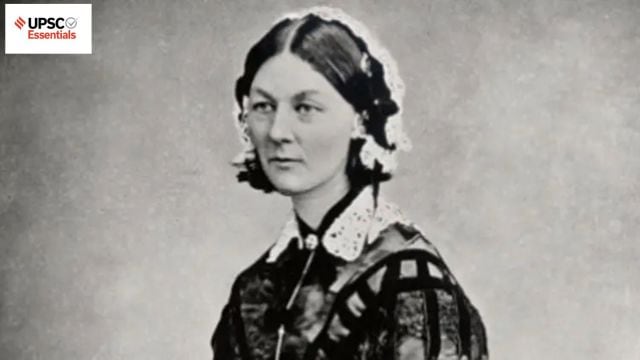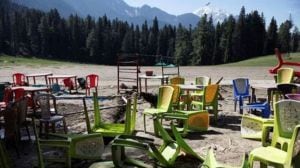UPSC Essentials | Mains answer practice — GS 1 : Questions on role of Florence Nightingale and community participation in combating river pollution (Week 97)
Are you preparing for CSE 2025? Here are questions from GS paper 1 for this week with essential points as the fodder for your answers. Do not miss points to ponder and answer in the comment box below.
 Attempt a question on the role of Florence Nightingale in transforming sanitation and public health policies in India in today's answer writing practice. (Source: Wikipedia)
Attempt a question on the role of Florence Nightingale in transforming sanitation and public health policies in India in today's answer writing practice. (Source: Wikipedia)UPSC Essentials brings to you its initiative for the practice of Mains answer writing. It covers essential topics of static and dynamic parts of the UPSC Civil Services syllabus covered under various GS papers. This answer-writing practice is designed to help you as a value addition to your UPSC CSE Mains. Attempt today’s answer writing on questions related to topics of GS-1 to check your progress.
🚨 Click Here to read the UPSC Essentials magazine for March 2025. Share your views and suggestions in the comment box or at manas.srivastava@indianexpress.com🚨
QUESTION 1
Evaluate the effectiveness of community participation and public awareness campaigns in combating river pollution. How can local communities be empowered to take active roles in river conservation?
QUESTION 2
Discuss the role of Florence Nightingale in transforming sanitation and public health policies in India during the British colonial period. How did her statistical approach and advocacy contribute to these reforms despite never visiting India?
General points on the structure of the answers
Introduction
— The introduction of the answer is essential and should be restricted to 3-5 lines. Remember, a one-liner is not a standard introduction.
— It may consist of basic information by giving some definitions from the trusted source and authentic facts.
Body
— It is the central part of the answer and one should understand the demand of the question to provide rich content.
— The answer must be preferably written as a mix of points and short paragraphs rather than using long paragraphs or just points.
— Using facts from authentic government sources makes your answer more comprehensive. Analysis is important based on the demand of the question, but do not over analyse.
— Underlining keywords gives you an edge over other candidates and enhances presentation of the answer.
— Using flowcharts/tree-diagram in the answers saves much time and boosts your score. However, it should be used logically and only where it is required.
Way forward/ conclusion
— The ending of the answer should be on a positive note and it should have a forward-looking approach. However, if you feel that an important problem must be highlighted, you may add it in your conclusion. Try not to repeat any point from body or introduction.
— You may use the findings of reports or surveys conducted at national and international levels, quotes etc. in your answers.
Self Evaluation
— It is the most important part of our Mains answer writing practice. UPSC Essentials will provide some guiding points or ideas as a thought process that will help you to evaluate your answers.
THOUGHT PROCESS
You may enrich your answers by some of the following points
QUESTION 1: Evaluate the effectiveness of community participation and public awareness campaigns in combating river pollution. How can local communities be empowered to take active roles in river conservation?
Note: This is not a model answer. It only provides you with thought process which you may incorporate into the answers.
Introduction:
— In a fresh report submitted to the National Green Tribunal (NGT), the CPCB stated that statistical analysis revealed that the water in the Ganga at Triveni Sangam in Prayagraj was safe for swimming during the Maha Kumbh.
— The report brings attention to the larger issue of river pollution in India, which is exacerbated by rising urbanisation and industrial growth. River pollution has a negative impact on public health and the environment, threatening biodiversity and aquatic ecosystems. The circumstance emphasises the critical necessity to combat river pollution and restore rivers to their former grandeur.
Body:
You may incorporate some of the following points in your answer:
— Under the National Water Quality Network, the CPCB, in collaboration with State Pollution Control Boards (SPCBs) and Pollution Control Committees (PCCs), conducts periodic evaluations to evaluate the water quality of various sources. Any length of the river with a Biological Oxygen Demand (BOD) of more than 3mg/l is classified as contaminated and unfit for outdoor bathing.
What are the causes of river pollution?
— The Supreme Court ruled in January of this year that tanneries in Tamil Nadu’s Vellore district had caused “irreversible damage to the waterbodies, groundwater, and agricultural lands” by discharging untreated or inadequately treated effluents into the Palar river. The Supreme Court referred to it as ‘ecocide’. The case illustrates the serious consequences of industrial pollution on water bodies.
— Untreated sewage is still the leading cause of river pollution in India. According to the CPCB, more than 60% of untreated sewage water is discharged into rivers every day, making the water hazardous and causing major problems for the local population and aquatic habitat.
— After untreated sewage, untreated industrial effluents are a major source of river pollution. Chemical, sugar, paper, and tannery industries all produce toxic effluent, which poses major dangers and, in some cases, lethal effects.
— Agricultural runoff also contributes to river contamination. It contains pesticides and fertilisers, which add hazardous substances to the water.
— Sand mining and unlawful encroachment are also causing substantial pollution in rivers. These operations interrupt the natural flow of rivers, increase the risk of floods in nearby areas, and contribute to river pollution caused by inadequate waste management systems.
— Every year, millions of tonnes of solid garbage are thrown directly into bodies of water due to inadequate waste management facilities and ineffective waste management regulatory enforcement.
Role of local communities in river conservation
— Over the years, the Indian government has implemented a number of river restoration initiatives. The most notable is the Ganga Action Plan (GAP), which was introduced in 1985. It was implemented in two stages, with the primary emphasis on sewage interception and treatment facilities.
— In 1996, the plan was combined with the National River Conservation Plan (NRCP). Similarly, the Yamuna Action Plan was launched in 1993. It was executed in three phases but faced similar issues to GAP.
— The Namami Gange Programme (NGP) took over from the GAP in 2014. The National Mission for Clean Ganga (NMCG) is implementing NGP. It took a comprehensive strategy and achieved significant progress on the issue of sewage treatment infrastructure, but problems such as unlawful encroachment, poor industrial compliance, and trash dumping continue on a huge scale.
Conclusion:
— The rejuvenation projects have made some progress. Encouraging community participation by raising awareness and promoting behavioural changes in waste creation and management could be beneficial. Furthermore, as pollutants change, preventive and controlling methods must be updated accordingly. Advanced technology, such as Artificial Intelligence, can be used for real-time monitoring and waste management.
— To some extent, rivers clean themselves. To ensure their natural flow, it is critical to address concerns such as significant river sand mining and encroachment. There is also a need to improve coordination among pollution control authorities, as well as collaboration between the government, industry, and the local community.
(Source: Rivers in peril: How pollution endangers India’s water lifelines)
To read more: Rivers in peril: How pollution endangers India’s water lifelines
Points to Ponder
How can river pollution be controlled?
How river interlinking is the solution for drought hit regions in India?
What is Biological Oxygen Demand?
Related Previous Year Questions
The interlinking of rivers can provide viable solutions to the multi-dimensional inter-related problems of droughts, floods, and interrupted navigation. Critically examine. (2020)
Why is the world today confronted with a crisis of availability of and access to freshwater resources? (2023)
QUESTION 2: Discuss the role of Florence Nightingale in transforming sanitation and public health policies in India during the British colonial period. How did her statistical approach and advocacy contribute to these reforms despite never visiting India?
Note: This is not a model answer. It only provides you with thought process which you may incorporate into the answers.
Introduction:
— Florence Nightingale was a renowned British social reformer, statistician, and the pioneer of modern nursing. She rose to popularity while working as a nurse during the Crimean War, where she cared for wounded soldiers. She was known as “The Lady with the Lamp” due to her practice of making rounds at night.
— Nightingale founded professional nursing in 1860, when she opened her nursing school at St Thomas’ Hospital in London. It was the world’s first secular nursing school, and is currently part of King’s College London. The Nightingale Pledge, which new nurses take, was named in her honour, and her birthday is recognised globally as International Nurses Day.
Body:
You may incorporate some of the following points in your answer:
— Nightingale’s Indian legacy is not without controversy. She became interested in the country following the Revolt of 1857, with the goal of lowering mortality rates among British soldiers and thereby bolstering Britain’s defence of India. However, her impact eventually spread to rural India, where she campaigned for a compassionate, data-driven, and preventative approach to healthcare.
— She never set foot on Indian soil, but her impact is as gritty and durable as the monsoon-soaked villages she worked to save.
— Nightingale showed quantitative skill at a young age, arranging garden data into numerical tables by the age of nine. Her early love with statistics paved the way for her subsequent contributions. During the Crimean War, she collected data like a biologist would collect specimens, assembling a team to analyse fatality statistics. Her studies found a 60% annual mortality rate for troops aged 25-35, which is twice that of civilians, with three times more deaths in peacetime owing to congestion and filth than during combat.
— This led to the creation of the polar area diagram, often known as the Nightingale rose diagram, which she first used in her 1858 book Mortality in the British Army. The figure, with blue wedges representing communicable diseases such as cholera and typhus, red for wounds, and black for other causes, visually indicated that avoidable diseases killed more people than injuries.
— Her groundbreaking visualisation techniques not only changed how data was disseminated at the time, but also paved the way for modern epidemiology, influencing the design of modern public health monitoring systems.
— Her statistical research in Life and Death in India (1974) revealed that mortality rates among British soldiers had reduced from around 69 per 1,000 per year to 18.69 per 1,000 by 1871, which she attributed to the reforms she fought for.
— Through correspondence with British officials and Indian reformers, she understood that poor sanitation also harmed people. In an 1865 letter to Sir Bartle Frere, Governor of Bombay, she stated that “the same causes which affect the health of the (British) army must also affect… the whole population of India.”
— The 1857 revolt shocked Britain’s grip on India, and Nightingale considered sanitation as critical not just to imperial stability but also to human dignity.
Conclusion:
— Nobel laureate Amartya Sen credited Nightingale with discovering that famines in British India were caused by transport failures due to a lack of political and social structure. She was known to criticise colonial policies that contributed to famine susceptibility, including poor agricultural techniques and economic exploitation. She called for reforms to help peasants overcome debt and poverty. Her efforts may also have tackled the root causes of famines, such as lobbying for irrigation projects, food distribution networks, and long-term agricultural sustainability.
— Nightingale never travelled to Calcutta or trekked through the mud of Punjab, but her memos and manifestos rained down on everyone. She oversaw the 1859 Royal Commission on the Sanitary State of the Army in India, a bureaucratic behemoth she discreetly guided, drawing questions and scrutinising responses.
— Nightingale’s impact persisted after independence. Her emphasis on data-driven policy inspired India’s first Five-Year Plan (1951), which focused on rural health. The National Rural Health Mission (2005) and Swachh Bharat Abhiyan (2014) both support her view that sanitation is a shared responsibility.
(Source: How Florence Nightingale revolutionised sanitation in India without setting foot in the subcontinent, nursingcouncil.tripura.gov.in)
Points to Ponder
Read about Florence Nightingale Awards
What is the polar area diagram?
Related Previous Year Questions
Discuss the main objectives of Population Education and point out the measures to achieve them in India in detail. (2021)
The women’s questions arose in modern India as a part of the 19th century social reform movement. What were the major issues and debates concerning women in that period? (2017)
Previous Mains Answer Practice
UPSC Essentials: Mains answer practice — GS 3 (Week 96)
UPSC Essentials: Mains answer practice — GS 3 (Week 97)
UPSC Essentials: Mains answer practice — GS 2 (Week 96)
UPSC Essentials: Mains answer practice — GS 2 (Week 97)
UPSC Essentials: Mains answer practice — GS 1 (Week 95)
UPSC Essentials: Mains answer practice — GS 1 (Week 96)
Subscribe to our UPSC newsletter and stay updated with the news cues from the past week.
Stay updated with the latest UPSC articles by joining our Telegram channel – IndianExpress UPSC Hub, and follow us on Instagram and X.
Must Read


Buzzing Now
May 03: Latest News
- 01
- 02
- 03
- 04
- 05
























